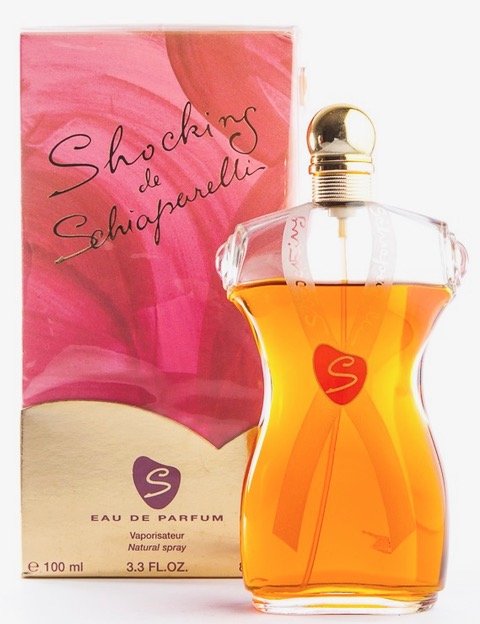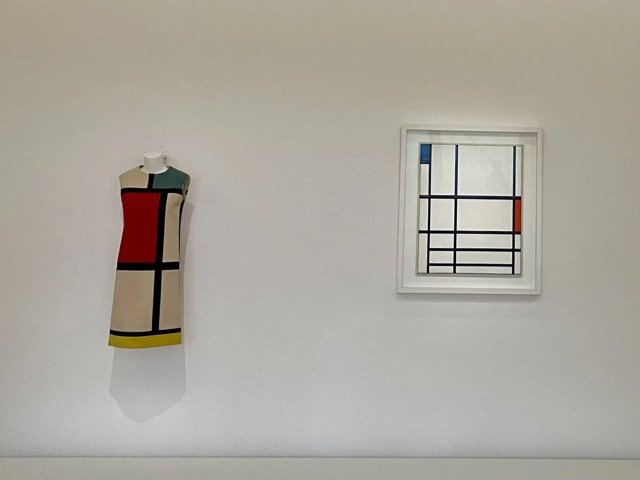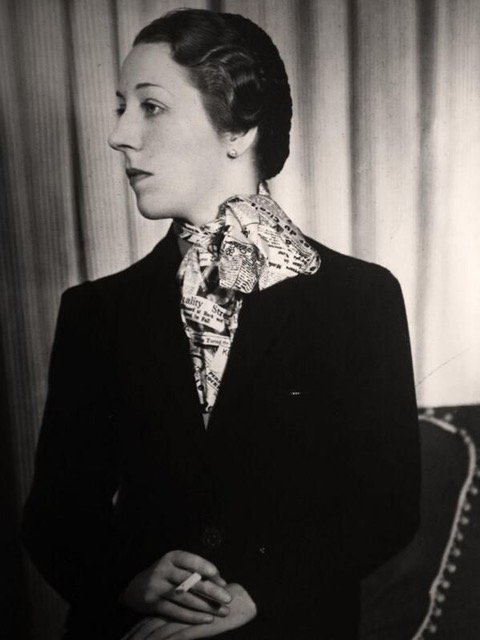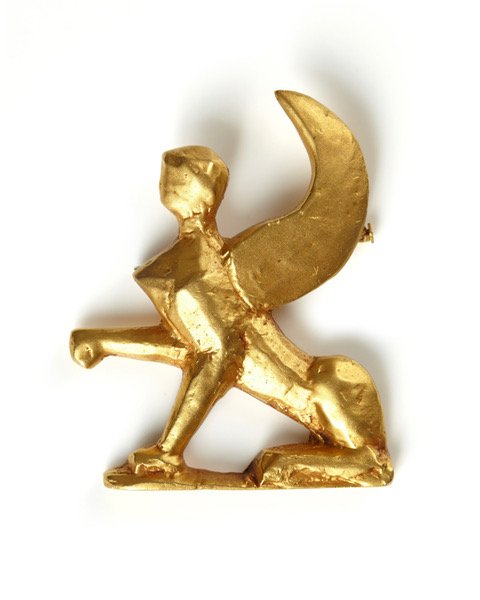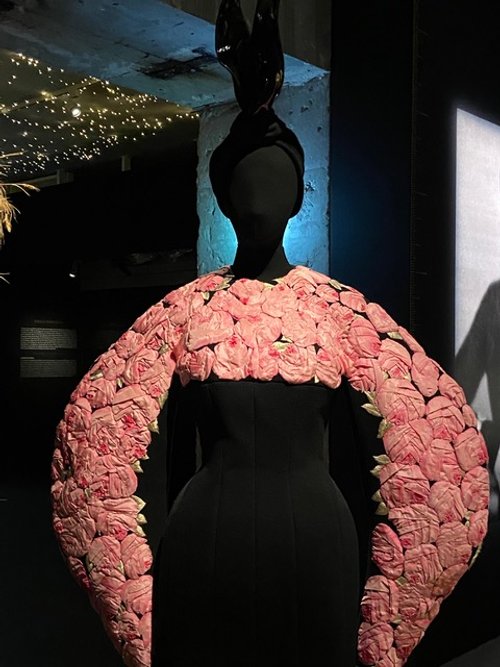Hot Pink Flashes
‘Shocking’ Musée des Arts Decoratifs
The exhibition about the fashion designer Elsa Schiaparelli (Musée des Arts Decoratifs until September) is called ‘Shocking’. Which is the name of Schiaparelli’s fragrance. Which she named after her signature color: Shocking Pink. The bottle’s shape is based on an icon’s torso. Mae West’s torso. (Figure 1)
Figure 1. Shocking, Elsa Schiaparelli perfume
The exhibition is glorious and gorgeous. And offers so much more than the delicious pleasure of complete immersion into the exquisitely detailed world of haute couture. Two themes swirl around nearly every display. Schiaparelli and artists. Schiaparelli and later designers. Collaboration and Inspiration.
About the second, Oscar Wilde said this, “Imitation is the sincerest form of flattery.” Wilde didn't invent the phrase, but he did elaborate upon it by adding “….that mediocrity can pay to greatness.” And he kept going with, “If any imitation is going to happen, let the mediocre imitate you.” The exhibition has a lot of imitation but it is presented as homage, as inspiration. Because the designers who imitate Schiaparelli were / are anything but mediocre.
I was thinking about homage vs plagiarism a few months ago when I was at the Musée Picasso, one of the venues for the multi museum exhibition on Yves Saint Laurent. I was admiring a painting by Picasso of Nusch Eluard. The actress, acrobat, artist and artist’s model (Man Ray, Picasso) who was married to the Surrealist poet Paul Eluard, whose first wife, Gala, married Salvador Dali after she and Eluard divorced. Next to Picasso’s painting was Saint Laurent’s riff on it. (Figure 2)
Figure 2. Portrait of Nusch Eluard by Picasso, 1937; Jacket, Yves Saint Laurent, 1979
In Picasso’s 1937 portrait of her, Nusch is wearing a jacket designed by Elsa Schiaparelli. The lapel pins, in the shape of cherubs, were designed by Jean Schlumberger. Who, before his 30 year career at Tiffany, designed playful buttons and jewelry like the ones on this jacket, for Schiaparelli.
For the Yves Saint Laurent exhibition, only his jacket and Picasso’s painting were on display. At this exhibition, the missing links are no longer missing. Both the Schiaparelli jacket and lapel pins are here. (Figures 3, 4) But now, I’m confused. YSL’s transformation of Mondrian paintings into wearable works of art was amazing. (Figure 5) But going from garment to garment even if through the intermediary of a painting, got me wondering if designers copyright their creations.
Figure. 3. Jacket, Elsa Schiaparelli, 1937
Figure 4. Cherub lapel pins, Jean Schlumberger for Schiaparelli, 1937
Figure 5. Dress by Yves Saint Laurent, Painting by Piet Mondrian
Copyright laws were first written to protect authors. Next came engravers. And now photographers, film makers and map makers, etc. are protected by copyright laws. Music is trickier since the line between plagiarism and influence is so difficult to determine. Lyrics can be copyrighted, individual words or short phrases cannot.
In fashion I was astonished to learn, the only things that can be copyrighted are the “non-functional” ones, like logos. (Figure 6) Utilitarian things, like clothes and shoes; cars and food, do not qualify for copyright protection because “everyday” things are so important to our ‘everyday’ lives. If they were copyrighted, we might be walking around (rather than driving) naked and eating whatever we can pull off trees. Which would probably be healthier! At a TED talk, Johanna Blakley suggested that the upside of plagiarism in fashion is its democratization. She’s talking about knockoffs, of course. Lower priced garments means that fashion is now available to people who can’t afford expensive clothes. I’m not prepared to concede that this is a good thing. It just leads to ‘fast fashion’ which, like ‘fast food’ is unhealthy for all of us, including the planet. Some designers, resigned to having their designs copied, have collaborated instead. Examples include Stella McCartney with Zara, JW Anderson with Uniqlo. Karl Lagerfeld (and so many others) with H & M.
Figure 6. Schiaparelli LOGO
Besides creating new things constantly, designers do something else, too. They create garments that are so intricate and so elaborate that they are too expensive to replicate. According to one fashion historian, without copyright protection, designers have raised fashion to the level of art. We have plagiarism to thank for haute couture. Designers copying other Designers.
Elsa Schiaparelli (Figure 7) was born into a wealthy aristocratic Italian family of intellectuals and academics whose areas of expertise included Egyptology and Sanskrit, astronomy and philosophy. She fit in intellectually but was too much of a free spirit to fit in culturally. Boarding school in Switzerland didn’t work, neither did taking care of orphans in London. She refused to return to Rome to marry the boring wealthy suitor her parents favored. In London one evening, she attended a theosophy meeting. Where she met and quickly married a man of dubious character and numerous aliases. They sailed for New York in 1916, but after bragging about being Bolsheviks, they decamped for Boston. When their daughter was born, Elsa’s husband decamped again, this time alone. With her young daughter, Schiaparelli returned to New York and befriended members of the Dada and Surrealist movements, like Man Ray and Marcel Duchamp.
Figure 7. Elsa Schiaparelli, 1934
Next, she found herself in Paris, under the wing of Paul Poiret, the designer famous for liberating women from their corsets. With no technical training, Schiaparelli created garments by draping fabric directly on the body of her model who was sometimes herself. Her garments came together as she draped. With her Dada and Surrealist sensibility, guided by impulse seems exactly right.
She started her own business in 1927 at the age of 37. Coco Chanel, Schiaparelli’s chief rival, referred to her as 'that Italian artist who makes clothes’. So, I guess if you had asked Chanel if fashion was art, she would have said yes.
Schiaparelli’s most famous collaborations were with Salvador Dali. And the most famous example of that collaboration is the Lobster Dress. A simple white silk evening dress on which Dali painted a large lobster. (Figure 8) Dali had been playing with lobsters for several years by then. (Figure 9) There’s a photo by Cecil Beaton of Wallis Simpson in the Lobster Dress taken right before she married for the third time, to the Duke of Windsor, the former King Edward VIII. (Figure 10)
Figure 8. The Lobster Dress, Elsa Schiaparelli dress, Salvador Dali, lobster, 1937
Figure 9. Lobster telephone, Salvador Dali, 1936
Figure 10. Wallace Simpson in Lobster Dress, Cecil Beaton photo, 1937
The Shoe Hat might be as famous as the Lobster Dress. In 1933, Dalí’s wife Gala photographed him wearing one of her slippers on his head. (Figure 11) Those Surrealists! Four years later, he sketched designs for a high heel shoe hat. The heel points straight up and the toe tilts over the wearer's forehead. (Figure 12) Gala Dalí wore the hat, so did Schiap and so did the editor of the French Harper’s Bazaar, the heiress Daisy Fellowes, one of Schiaparelli’s best clients.
Figure 11. Salvador Dali with shoe on his head, photo by Gala Dali, 1933
Figure 12. Model wearing Shoe Hat, 1937
Schiaparelli and Dali also collaborated on a day dress called the Desk Suit. (Figure 13) It has pockets that make it look like a chest of drawers, a direct reference to Dali’s painting The Anthropomorphic Cabinet, (Figure 14).
Figure 13. Desk suit, Cecil Beaton, photo
Figure 14. Anthropomorphic Cabinet, Salvador Dali, 1936
The Tears Dress (not boohoo tears, but the present tense of torn, tears) is a light blue sheath printed with Dalí designed trompe l’oeil rips and tears. The veil has actual tears, that is, rips, cut out and lined in pink and magenta. (Figure 15) Rips and tears on skin tight clothes suggests flayed flesh. Another reference to Dali, this time to Necrophiliac Springtime, (Figure 16) a painting Schiaparelli owned.
Figure 15. The Tears Dress, Elsa Schiaparelli, 1938
Figure 16. Necrophiliac Springtime, Salvador Dali, 1936
Schiaparelli shows were presented thematically. The Tears dress was part of her 1938 Circus Collection. It included dancers and clowns, balloon handbags and ice cream cone hats, embroidered designs of ringmasters and acrobats. A touch of surrealism with a dash of fear. Harbingers of war were all around. (Figure 17)
Figure 17. Pieces from the Circus Collection, Elsa Schiaparelli, 1938
Following Schiaparelli’s lead, fashion designers have created themed collections, like Yves Saint Laurent’s Bohemian, Ballets Russes, Bonnard collections and Jean Paul Gaultier’s Hasidic Jews, Mongols, Chinese collections.
Schiaparelli worked with other artists, among them, Jean Cocteau. He is represented at this exhibition by an evening jacket embroidered with a female figure whose hand caresses the waist of the jacket and whose long blonde hair tumbles down one of the sleeves. (Figure 18) And by an evening coat embroidered with a pattern that reads simultaneously as a vase and two faces (Figure 19).
Figure 18. Evening Jacket, Elsa Schiaparelli based on design by Jean Cocteau
Figure 19. Evening Coat, Elsa Schiaparelli, based on design by Jean Cocteau
Schiaparelli designed wardrobes for films, too, like Zsa Zsa Gabor’s outfits for the 1952 film Moulin Rouge, a biography of Toulouse-Lautrec. Gabor played the dancer, Jane Avril, made famous by Lautrec’s paintings of her. (Figures 20, 21) But Schiaparelli didn’t get credit for Gabor’s costumes. Because she based Gabor’s costumes on portraits of Avril by Toulouse-Lautrec? How that is any different from Yves Saint Laurent’s much heralded recreation of Nusch’s jacket from a painting by Picasso which was originally designed by Schiaparelli, I can’t tell you.
Figure 20. Zsa Zsa Gabor as Jane Avril in film Moulin Rouge, 1952
Figure 21. Jane Avril, Toulouse-Lautrec, 1899
Schiaparelli had already designed Mae West’s outfits for the 1937 film, Every Day’s a Holiday. (Figure 22) Which is how West’s body became the inspiration for the bottle of Schiaparelli’s perfume, Shocking. Which was long before Gaultier designed perfume bottles in the shape of female torsos (Figure 23 - see above Figure 1).
Figure 22. Mae West in film, Everyday’s a Holiday, 1937
Figure 23. Perfume bottle, Jean Paul Gaultier
Which is a good segue to the theme of imitation, or if you prefer, emulation. According to Olivier Gabet, the curator of the exhibition, “everybody helped themselves” to Schiaparelli’s designs when her couture house closed in 1954. Examples abound, and are celebrated in the exhibition, like Gaultier corsets, Yves Saint Laurent’s homages to artists and John Galliano’s ‘Gazette’ newsprint (Figure 24, 25).
Figure 24. Stop Look Listen Collection, Newsprint, Elsa Schiaparelli
Figure 25. Newsprint ensemble, John Galliano
But the House of Schiaparelli is back in the game with a young American designer from Texas, Daniel Roseberry at the helm. He was 33 in 2019 when he became creative director, four years younger than Schiap when she opened her shop. He can rifle through the archives whenever he wishes. Roseberry said that initially he hesitated to immerse himself in all that history. But when he found a Sphinx brooch designed by Alberto Giacometti from 1938-39, (Figure 26) he changed his mind. According to Roseberry, the brooch “unlocked all the jewelry we do today.” Since then he has “… been falling more and more in love with the archives...”Vogue.com
Figure 26. Sphinx, Alberto Giacometti for Elsa Schiaparelli, 1938-39
Daniel Roseberry’s Autumn/Winter 2022 défilé (fashion show) was held at the Musée des Arts Decoratifs, although not in the same wing as the exhibition. But it seemed, to more than one reviewer, that as the models walked off the catwalk, they walked into the exhibition. And several of the outfits shown on the runway are featured in the exhibition. Like a black velvet coat with drawer shaped pockets referencing the “Bureau Drawer” (Figure 27) suit Schiaparelli created with artist Salvador Dalí in 1936, inspired by Dali’s painting The Anthropomorphic Cabinet. (See above, Figures 13, 14) Other pieces are elaborations on Schiaparelli’s designs (Figure 28)
Figure 27. Bureau Dress, Daniel Roseberry, House of Schiaparelli
Figure 28. Cape, Daniel Roseberry for House of Schiaparelli (see above Figure 19)
“The idea was to pay homage to Elsa’s relationship with artists, but also with visual culture,” explained curator Olivier Gabet. ]“I think (said Roseberry) that when she was working with Cocteau and Dalí …, those barriers between art and fashion were begging to be broken down.” Poiret was her mentor but Dali and Cocteau were her inspirations. As were Italian Renaissance artists like Fra Angelico and Botticelli.
If the exhibition doesn’t answer the question: Is fashion art, maybe it’s because Schiaparelli considered herself an artist. And Roseberry considers himself one, too “I know that I am an artist, … if I draw a .. nude body, that’s art, but if she’s wearing clothes, it’s a fashion drawing? Give me a break….” (Figure 29)
Figure 29. Daniel Roseberry working during most recent Schiaparelli fashion show
This exhibition was ostensibly about Elsa Schiaparelli but its focus is almost as much on the current creative director. And his recent successes. Lady Gaga’s dress for President Biden’s inauguration (Figure 30) which she wore to sing the National Anthem is here. So is Beyoncé’s outfit for the 63rd Grammy Award (Figure 31) and the breastplate dress Bella Hadid wore at Cannes. (Figure 32) All show stoppers. I was reminded of Thierry Mugler’s over the top designs for Beyoncé, Cardi B and Kim Kardashian (33, 34). But to my eyes, more refined, more elegant. More couture than costume. Of course Ginevra and I loved the Schiaparelli pieces but we couldn’t help but compare her work to Roseberry’s. His interpretations are so much more refinée. He and all the ‘petit mains’ working with him achieve a level of detail and perfection using modern techniques that were not available to previous generations. Schiaparelli got as far as she could, Roseberry consistently takes everything farther. To a level that is stupéfiant (breathtaking). (Figure 35)
And, most recently (3 days ago) the incomparable Cate Blanchett wore Schiaparelli Haute Couture by Daniel Roseberry to the Venice Film Festival, the corseted top detailed with flowers turned the actress into her own bouquet. I think Dali would have approved. (Figure 36)
Figure 30. Dress lady Gaga wore to President Biden’s Inauguration, 2021, Roseberry for Schiaparelli
Figure 31. Dress Beyoncé wore to 63rd Grammy Awards, Roseberry for Schiaparelli
Figure 32. Bella Hadid at Cannes, Roseberry for Schiaparelli
Figure 33. Cardi B, gown by Manfred Thierry Mugler
Figure 34. Kim Kardashian, gown by Manfred Thierry Mugler
Figure 35. Daniel Roseberry, House of Schiaparelli, Spring/Summer 2021
Figure 36. Cate Blanchett at the Venice Film Festival (September 1, 2022), Daniel Roseberry, House of Schiaparelli.
Copyright © 2022 Beverly Held, Ph.D. All rights reserved
Dear Reader, I hope you enjoyed reading this article. Please sign up below to receive more articles plus other original content from me, Dr. B. Merci!
And, if you enjoyed reading this review, please consider writing a comment. Thank you.
